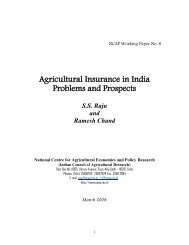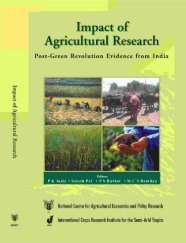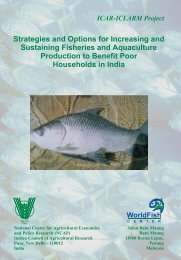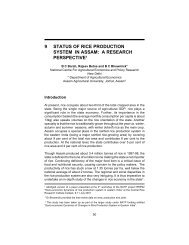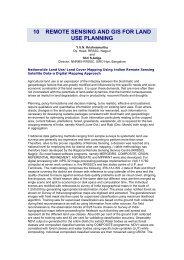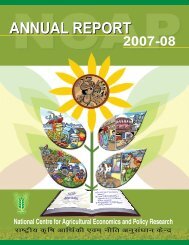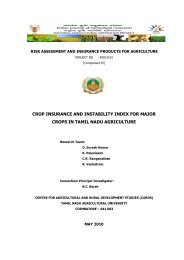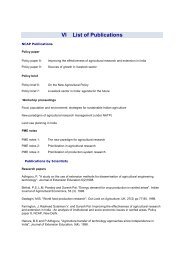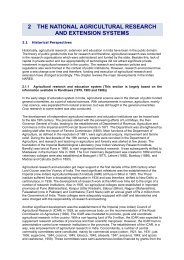Biofuels in India: Future Challenges - NCAP
Biofuels in India: Future Challenges - NCAP
Biofuels in India: Future Challenges - NCAP
- No tags were found...
Create successful ePaper yourself
Turn your PDF publications into a flip-book with our unique Google optimized e-Paper software.
an estimated area of 13.4 million hectares of marg<strong>in</strong>al /wasteland that is suited to grow<strong>in</strong>g of jatropha and cancater to large-scale plant<strong>in</strong>g so as to meet the blend<strong>in</strong>gtargets. Similarly, the Department of Land Resourcesunder the M<strong>in</strong>istry of Rural Development, GoI, hasestimated that around 25 million hectares of fallow landis available <strong>in</strong> the country that can be diverted for grow<strong>in</strong>gof feed stock crops, <strong>in</strong>clud<strong>in</strong>g jatropha. Given these facts,currently there is no apprehension about a threat to foodsecurity <strong>in</strong> <strong>India</strong> from the commercial biofuel blend<strong>in</strong>gprograms as opposed to the case with other major biofuelproduc<strong>in</strong>g countries.Present Status of Biofuel Production andUtilizationCurrently, <strong>India</strong>’s biofuel production accounts for only1 per cent of its global production. <strong>India</strong> has about 320distilleries with the production capacity of over 3.50billion litres of alcohol every year. In the year 2008, thecountry produced nearly 2.15 billion litres of ethanol,of which an estimated 280 million litres of ethanol wereblended with petrol. As ethanol has many alternativeuses such as <strong>in</strong> the potable liquor and <strong>in</strong> chemical andpharmaceutical <strong>in</strong>dustries, its availability for blend<strong>in</strong>gwith petrol is highly dependant on the prevail<strong>in</strong>g marketprices which determ<strong>in</strong>e its viability for the Oil Market<strong>in</strong>gCompanies (OMCs) for its use as a fuel. Because of thecyclical nature of sugar cane production and consequentshortfalls <strong>in</strong> molasses availability, the government has notbeen able to meet its mandated blend<strong>in</strong>g target of 5 percent 1 so far. In April 2010, the government decided toraise the m<strong>in</strong>imum purchase price (MPP) of ethanol toRs. 27.00 per litre from the previous level of Rs. 21.50per litre so as to <strong>in</strong>crease its availability for blend<strong>in</strong>g. Withthe <strong>in</strong>creased price and the expected surplus productionof sugar cane <strong>in</strong> 2010-11, the government hopes to meetthe targets this year.Large-scale blend<strong>in</strong>g of biodiesel with conventional dieselhas not yet started <strong>in</strong> <strong>India</strong>. Around 20 biodiesel plantsannually produce 140- 300 million litres of biodieselwhich is mostly utilized by the <strong>in</strong>formal sector locallyfor irrigation and electricity generation and by theautomobile and transportation companies for runn<strong>in</strong>gtheir experimental projects (USDA, 2010). The NationalBiodiesel Mission launched by the Plann<strong>in</strong>g Commissionhas focused on expansion of jatropha area <strong>in</strong> two phases.The first phase which was the demonstration phase, wastaken up dur<strong>in</strong>g 2003-2007 and <strong>in</strong>cluded several micromissionson jatropha cover<strong>in</strong>g promotion of its large-scaleplantations <strong>in</strong> forests and wastelands, procurement of seedand oil extraction, transesterification, blend<strong>in</strong>g and tradeand technological research and development. The secondphase of expansion targets to make the program selfsusta<strong>in</strong>ableby produc<strong>in</strong>g enough biodiesel to meet the 20per cent blend<strong>in</strong>g target (NCAER, 2007). To ensure a fairprice to the jatropha farmers, various state governmentshave offered a m<strong>in</strong>imum purchase price (MPP) forjatropha seeds. The MPP is announced for biodiesel also,the present rate be<strong>in</strong>g Rs 26.50 per litre for biodiesel. Inaddition, some subsidy programs and tax concessions/exemptions are also part of the government’s efforts toboost the production of feed stocks for biofuels. Severalpublic <strong>in</strong>stitutions like National Oilseeds and VegetableOils Development Board (NOVOD) under the M<strong>in</strong>istryof Agriculture, Government of <strong>India</strong>, state biofuelboards, state agricultural universities and non-stateactors like non-governmental organizations (NGOs),self-help groups (SHGs), co-operative societies, etc. arealso actively support<strong>in</strong>g the biofuel program <strong>in</strong> variouscapacities.<strong>Challenges</strong> before Biofuel IndustryThe major challenges before biofuel <strong>in</strong>dustry are discussedseparately for bioethanol and biodiesel.BioethanolWith ris<strong>in</strong>g per capita <strong>in</strong>come, urbanization, <strong>in</strong>frastructuraldevelopment and the resultant <strong>in</strong>crease <strong>in</strong> vehicular density,the demand for petrol <strong>in</strong> <strong>India</strong> is gallop<strong>in</strong>g – the rate ofgrowth <strong>in</strong> demand has been 8.5 per cent for petrol, 3.0 percent for ethanol for <strong>in</strong>dustrial and other uses and 3.3 percent for ethanol for potable use dur<strong>in</strong>g the five-year period2004-05 to 2008-09. These growth rates are expected tocont<strong>in</strong>ue over the next several years. With the governmentplann<strong>in</strong>g to br<strong>in</strong>g <strong>in</strong>to effect 20 per cent blend<strong>in</strong>g of petrolwith bioethanol by 2017, it is important to anticipate thedemand for ethanol for it, so that necessary measurescould be undertaken to achieve the targets. Keep<strong>in</strong>g this<strong>in</strong> view, the demand for ethanol as fuel and for otheralternative uses was projected us<strong>in</strong>g the growth rate forthe period 2004-05 to 2008-09 (Table 1). It was found thatthe fuel ethanol demand dur<strong>in</strong>g 2011-12 for 5 per cent,10 per cent and 20 per cent blend<strong>in</strong>g would be 0.72 Mt,1.44 Mt and 2.87 Mt, respectively (925 million litres, 18401The Government of <strong>India</strong> has made 5 per cent blend<strong>in</strong>g of ethanol with petrol mandatory s<strong>in</strong>ce 2003 across 9 states and 5 union territories. In 2006, this wasextended to 20 states and 8 union territories. The blend<strong>in</strong>g mandate is to be raised to 10 per cent from 2011 and further to 20 per cent by the year 2017, as perthe official Policy.
Table 1. Projected ethanol demand for various uses <strong>in</strong> <strong>India</strong>(million tonnes)Year Petrol Fuel ethanol demand Potable ethanol Industrial and other Total ethanol demanddemand5 % 10 % 20 %demand uses ethanol demand5 % 10 % 20 %2008-09 11.25 0.56 1.13 2.25 0.65 0.60 1.81 2.38 3.502011-12 14.37 0.72 1.44 2.87 0.71 0.65 2.08 2.80 4.232016-17 21.61 1.08 2.16 4.32 0.84 0.76 2.68 3.76 5.922020-21 29.94 1.50 2.99 5.99 0.96 0.85 3.31 4.80 7.80million litres and 3680 million litres, respectively) 2 . Thecorrespond<strong>in</strong>g total ethanol demand after account<strong>in</strong>g forpotable, <strong>in</strong>dustrial and other uses would be 2.08 Mt, 2.80Mt and 4.23 Mt, respectively. In the year 2016-17, whenblend<strong>in</strong>g at 20 per cent is to be commenced, the totalethanol requirement would be 5.92 Mt which is equivalentto 6704 million litres 3 .It is quite clear from the above analysis that to atta<strong>in</strong> 20per cent blend<strong>in</strong>g target without compromis<strong>in</strong>g on the<strong>in</strong>dustrial, potable and other requirements, <strong>India</strong> has toeither <strong>in</strong>crease its ethanol production nearly 3-times of thepresent levels or go for massive imports of ethanol. Thereare several constra<strong>in</strong>ts <strong>in</strong> <strong>in</strong>creas<strong>in</strong>g ethanol productionto such levels, given the fact that sugar cane yield <strong>in</strong> thecountry has been stagnant at around 60-65 tonnes perhectare for the past several years. It also does not appearfeasible to <strong>in</strong>crease area under sugar cane as this will be atthe cost of divert<strong>in</strong>g land from other staple food crops.Sugar cane be<strong>in</strong>g a crop that consumes about 20,000-30,000 cubic metres of water per hectare per crop, overexploitationof the groundwater for energy productionwould not be a susta<strong>in</strong>able option. Production of ethanoldirectly from sugarcane juice, a more efficient method,would constra<strong>in</strong> sugar production for the food market.Moreover, even occasional shortage of molasses bids upthe cost of ethanol production, mak<strong>in</strong>g its blend<strong>in</strong>g withpetrol an uneconomical proposition. Import of ethanol forfuel usage is currently restricted through policy and evenif made free, would cost the exchequer very dearly, as the<strong>in</strong>ternational markets for ethanol are already very tight dueto demand from other biofuel-consum<strong>in</strong>g countries.BiodieselAs <strong>in</strong> the case of petrol, the demand for diesel has alsobeen <strong>in</strong>creas<strong>in</strong>g at the rate of 7.5 per cent per annum s<strong>in</strong>ce2004-05. Demand projections for diesel suggest that nearly3.21 million tonnes of biodiesel would be required for 5per cent blend<strong>in</strong>g by the year 2011-12 (Table 2).To br<strong>in</strong>g this <strong>in</strong>to effect, assum<strong>in</strong>g that jatropha wouldbe the major feedstock for biodiesel (i.e., 80 % ofthe requirement would be met from jatropha) with anaverage seed yield 4 of 2.5 t/ha and 30 per cent biodieselrecovery rate, the area required under the crop has beenworked out to be 3.42 million hectares. An estimatedarea of 26.25 million hectares would be required underjatropha to meet 20 per cent blend<strong>in</strong>g target by the year2020-21, if the yield and oil content of jatropha rema<strong>in</strong>sthe same and that no new superior feedstocks areTable 2. Projections of biodiesel demand and correspond<strong>in</strong>g jatropha area required for meet<strong>in</strong>g the blend<strong>in</strong>g targets <strong>in</strong><strong>India</strong>(Area <strong>in</strong> million ha, Demand <strong>in</strong> million tonnes)YearDieseldemandAt 5 % blend<strong>in</strong>g At 10 % blend<strong>in</strong>g At 20% blend<strong>in</strong>gBiodieseldemandJatropha areaBiodieseldemandJatropha areaBiodieseldemandJatropha area2011-12 64.19 3.21 3.42 6.42 6.85 12.84 13.692016-17 92.15 4.61 4.91 9.21 9.83 18.43 19.662020-21 123.06 6.15 6.56 12.31 13.13 24.61 26.25Note: The compound annual growth rate dur<strong>in</strong>g the five years end<strong>in</strong>g 2008-09 for diesel demand (7.5 %) was used for trend projections.2Our estimates for petrol demand were found comparable with those of Petroleum Plann<strong>in</strong>g and Analysis Cell (PPAC), M<strong>in</strong>istry of Petroleum and Natural gases,GoI (Latest PPAC estimate of petrol demand for 2020-21 is 25.4 Mt).31 metric tonne of ethanol is equivalent to 1267 litres (Density of ethanol is 0.789 g/mL)4The <strong>NCAP</strong> survey conducted at Rajasthan, Chhattisgarh and Uttarakhand suggests that the average yield of jatropha under normal management practices <strong>in</strong>farmers’ field ranges between 2.0 and 2.9 t/ha. See Sh<strong>in</strong>oj et al., (2010) for more details.
<strong>in</strong>troduced. So far <strong>in</strong> the country, only around 0.5 millionhectares land has been put under jatropha cultivationand the government has not <strong>in</strong>itiated purchas<strong>in</strong>g ofbiodiesel through the designated purchase centres eventhough an MPP of Rs 26.50 per litre was announced afew years ago.There are several reasons beh<strong>in</strong>d the slow progress of<strong>India</strong>’s national biofuels program towards its statedgoals. The jatropha production program was startedrather <strong>in</strong> haste without any planned varietal improvementprogram preced<strong>in</strong>g it. In almost every state where itwas implemented, conventional low-yield<strong>in</strong>g cultivarswere used for new plant<strong>in</strong>gs of feedstocks. Because ofthis reason, the producers are not comfortable with theyields of the crop, especially under low managementconditions 5 , as <strong>in</strong>dicated by the field studies. Moreover,the longer gestation period (3-4 years) of jatropha alsodiscourages the farmers <strong>in</strong> places where state supportis not readily available. However, a f<strong>in</strong>ancial assessmentbased on discounted measures 6 on long-term <strong>in</strong>vestmenton jatropha cultivation has suggested promis<strong>in</strong>g prospects.The estimates of net present value (NPV), benefit-costratio (BCR) and <strong>in</strong>ternal rate of return (IRR) on jatropha<strong>in</strong>vestment (Table 3) were found to be encourag<strong>in</strong>g andsuggest that with some <strong>in</strong>itial support, jatropha cultivationcould be made profitable <strong>in</strong> farmers’ field. The relativelyhigher estimates for the state of Chhattisgarh could beattributed to lower cost of jatropha production and itshigher yields <strong>in</strong> the state.Table 3. F<strong>in</strong>ancial measures for assess<strong>in</strong>g the feasibility of<strong>in</strong>vestment <strong>in</strong> jatropha cultivation <strong>in</strong> three states of <strong>India</strong>State NPV (Rs) BCR IRR (%)Rajasthan 47310 1.47 25Chhattisgarh 100265 10.18 85Uttarakhand 48743 1.81 45Note: The economic life-span of jatropha was assumed to be 20 years; A 10per cent discount rate was used for the calculations.Table 4. Cost of production of biodiesel <strong>in</strong> Rajasthan and Chhattisgarh - A comparisonInputsThe jatropha seed distribution channels are currentlyunderdeveloped as sufficient numbers of process<strong>in</strong>g<strong>in</strong>dustries are not operat<strong>in</strong>g. Even though, several privatecompanies have ventured <strong>in</strong>to jatropha cultivation andbiodiesel production, their <strong>in</strong>volvement is still very low.There are no specific markets for jatropha seed supply andhence the middlemen play a major role <strong>in</strong> tak<strong>in</strong>g the seedsto the process<strong>in</strong>g centres and this <strong>in</strong>flates the market<strong>in</strong>gmarg<strong>in</strong>. The process<strong>in</strong>g <strong>in</strong>dustry suffers from low backward<strong>in</strong>tegration with the seed market and forward <strong>in</strong>tegrationwith biodiesel distribution channels. The distributionchannels are almost non-existent as most of the biofuelproduced is used either by the produc<strong>in</strong>g companies forself-use or by certa<strong>in</strong> transport companies on a trial basis.Unless large-scale use of biodiesel commences or a demandpull from mandatory blend<strong>in</strong>g of biodiesel comes, thesechannels would rema<strong>in</strong> under-developed. Further, the costof biodiesel depends substantially on the cost of seedsand the economy of scale at which the process<strong>in</strong>g plantis operat<strong>in</strong>g. The <strong>NCAP</strong> study on process<strong>in</strong>g <strong>in</strong>dustriesRSMML plantCBDA plantQuantity/day Value (Rs) Quantity/day Value (Rs)Jatropha seeds 1 tonne 12000 10 tonnes 65000Labour 4 man days 1000 11 man days 2920Chemicals 680 7140Electricity 25 units 250 250 units 2500Interest on fixed capital @10 % 650 @10 % 6800Depreciation on fixed assets # @4 % 710 @4 % 4440Incidentals 350 6500a. Total cost 15640 95300b. Revenue from5580 44024by-productsNet cost <strong>in</strong>curred (a-b) 10060 51276Net cost/kg of biodiesel 40.24 18.78Notes: The recovery of biodiesel from RSMML plant: 250 kg/tonne of seeds; CBDA plant: 273 kg/tonne of seeds;#4 per cent depreciation on fixed assets and 10 per cent on mach<strong>in</strong>ery were used for the calculations.Source: <strong>NCAP</strong> Field Survey on <strong>Biofuels</strong>5The yield can be as low as 500 kg/ha if no <strong>in</strong>itial irrigation and fertilizer application are provided.6Assumed that the parity between the seed prices and cost of <strong>in</strong>puts would rema<strong>in</strong> the same as of today, throughout the economic lifespan of jatropha.
from Rajasthan [Rajasthan State M<strong>in</strong>es and M<strong>in</strong>eral Ltd.(RSMML) plant) and Chhattisgarh (Chhattisgarh BiofuelDevelopment Authority (CBDA) plant] amply suggests thatthe cost of production of biodiesel can vary from Rs 19/kgto Rs 40 / kg (Table 4), depend<strong>in</strong>g upon various economicconditions under which they are operated. Major factorsresponsible for higher cost of production at RSMML plant<strong>in</strong>clude higher seed cost, higher transaction cost due to<strong>in</strong>volvement of middlemen, under-utilization of labourand other staff <strong>in</strong> the process<strong>in</strong>g plant, higher wage rates,lower biodiesel recovery, etc (sh<strong>in</strong>oj et al., 2010).Address<strong>in</strong>g the Constra<strong>in</strong>ts and Mov<strong>in</strong>g ForwardFor build<strong>in</strong>g a susta<strong>in</strong>able and viable biofuel <strong>in</strong>dustry <strong>in</strong> thecountry, it is high time to look for alternative options thatwould not only help meet the immediate targets but alsopay dividends <strong>in</strong> the long-run. In the case of bioethanol<strong>in</strong>dustry, the country needs improved technology andmanagement practices that would br<strong>in</strong>g down costs. Lowerplant capacity, use of batch-process technology, <strong>in</strong>efficientby-product and effluent management practices, etc. areconsidered as major technological constra<strong>in</strong>ts. Severalethanol plants <strong>in</strong> the country are operat<strong>in</strong>g below their fullproduction capacity which leads to diseconomies of scaleand needs <strong>in</strong>terventions. Long-term technological targetslike application of biotechnology to <strong>in</strong>crease sugar content<strong>in</strong> sugar cane, commercial use of membranes and microbesfor enhanc<strong>in</strong>g ethanol recovery from molasses, etc. canalso be thought of. Another option is to complementethanol production us<strong>in</strong>g alternative feedstocks like sweetsorghum, tropical sugar beet, etc. that can yield higherethanol at lower costs as compared to molasses-basedproduction 7 . Sweet sorghum is a rapidly grow<strong>in</strong>g cropwith wider adaptability and higher biomass produc<strong>in</strong>gability and thrives well <strong>in</strong> dry tracts. Several studies (Raoand Bantilan, 2007; Reddy et al., 2005) have establishedthe suitability of sweet sorghum for commercial ethanolproduction. Sugar beet grows well <strong>in</strong> the sal<strong>in</strong>e and alkal<strong>in</strong>esoils that are not suited to other food crops. It has lowcrop duration, higher sugar content, higher ethanol yieldand requires less irrigation and fertilizer as compared tosugar cane (TNAU, 2009). Exploit<strong>in</strong>g such advantagesof these alternative crops without compromis<strong>in</strong>g foodproduction is a challenge that needs urgent attention.Focus<strong>in</strong>g research efforts on commercial production ofethanol from second-generation feedstocks like bagasse,crop residues of cereals, forest th<strong>in</strong>n<strong>in</strong>gs, saw-dust, wastepaper, etc. is equally important <strong>in</strong> ensur<strong>in</strong>g the long-termenvironmental susta<strong>in</strong>ability and benefits of biofuels (Rajuet al., 2009).In spite of several promotional measures by both statesand centre, it is apparent that a self-susta<strong>in</strong><strong>in</strong>g atmospherefor the development of a stable feedstock productionsystem and biodiesel supply cha<strong>in</strong> has not been createdso far. The area coverage under feedstocks and the<strong>in</strong>stitutional and <strong>in</strong>frastructural framework to supportthe program have been sub-optimal. In this context,favourable policies like ensur<strong>in</strong>g <strong>in</strong>itial government support<strong>in</strong> the form of subsidized <strong>in</strong>puts, technical assistance,buy-back arrangements and m<strong>in</strong>imum support prices <strong>in</strong>the marg<strong>in</strong>al areas, enhanc<strong>in</strong>g community participation <strong>in</strong>cultivation, extend<strong>in</strong>g land titles to landless farmers andtribal people <strong>in</strong> forest areas for jatropha cultivation, etc.would have catalytic effect. Other beneficial <strong>in</strong>itiatives<strong>in</strong>clude: a centrally coord<strong>in</strong>ated research program onvarietal improvement of jatropha and other feedstockgermplasm that replaces the current piecemeal approach;conscientious selection of geographical locations forplant<strong>in</strong>g the feedstock crops for ensur<strong>in</strong>g environmentalsuitability and prevent<strong>in</strong>g use of fertile lands for theircultivation; encourag<strong>in</strong>g private sector <strong>in</strong>volvement <strong>in</strong>grow<strong>in</strong>g the feedstock crops and sett<strong>in</strong>g-up of process<strong>in</strong>gand market<strong>in</strong>g <strong>in</strong>frastructure; area-wise critical assessmentthat precedes <strong>in</strong>vest<strong>in</strong>g <strong>in</strong> process<strong>in</strong>g <strong>in</strong>frastructure so asto fully utilize the economies of scale <strong>in</strong> process<strong>in</strong>g; andstate <strong>in</strong>tervention <strong>in</strong> creat<strong>in</strong>g market<strong>in</strong>g and <strong>in</strong>stitutional<strong>in</strong>frastructure for jatropha seed and biodiesel supply cha<strong>in</strong>.Therefore, adopt<strong>in</strong>g a holistic approach for simultaneouslydevelop<strong>in</strong>g production, process<strong>in</strong>g and market<strong>in</strong>g systemswith specific thrust on the above-mentioned <strong>in</strong>itiativescould prove <strong>in</strong>strumental <strong>in</strong> ensur<strong>in</strong>g the success of theprogram.ConclusionsThe importance of develop<strong>in</strong>g a strong biofuel <strong>in</strong>dustryto tackle the challenges of energy security and fuel selfsufficiencyhas been widely acknowledged <strong>in</strong> <strong>India</strong>. Eventhough the food versus fuel debate is quite relevant at theglobal level, it is largely irrelevant to the <strong>India</strong>n biofuelproduction program due to the country’s policy decisionnot to use any edible feedstock for bio-energy production.The National Biofuel Policy has been designed to harnessthe various environmental, social and economic benefitsaris<strong>in</strong>g out of large-scale development of biofuels <strong>in</strong> thecountry. However, the success of the program wouldlargely depend on the read<strong>in</strong>ess of the stakeholders andthe government mach<strong>in</strong>ery to tackle the challenges thatthe program may face from time to time. It has becomeapparent that bioethanol production solely based onsugar cane molasses is neither economically viable nor7See Sh<strong>in</strong>oj et al., (2011) for a comparison on resource requirement as well as cost estimates of alternative feed stocks.
susta<strong>in</strong>able <strong>in</strong> the long-run. Similarly, the jatropha basedbiodiesel production program is bogged down with severalobstacles like slow progress <strong>in</strong> plant<strong>in</strong>g, sub-optimalprocess<strong>in</strong>g and market<strong>in</strong>g <strong>in</strong>frastructure, under-developeddistribution channel, etc. While favourable governmentpolicies, vigorous participation of local community andprivate entrepreneurs can susta<strong>in</strong> the program <strong>in</strong> the shortterm,it is equally important to have a sound long-termstrategy at our disposal. The current course is not likelyto be adequate <strong>in</strong> the long-run, given the present choiceof feedstocks, status of technology and available policy.Substantial research thrust on development of second andthird generation feedstocks is crucial to address the futurebio-energy needs of the country.ReferencesChand, R. (2008) The global food crisis: Causes, severityand outlook. Economic and Political Weekly, 43 (26): 115-123.GoI (Government of <strong>India</strong>) (2003) Report of the Committee onDevelopment of <strong>Biofuels</strong>, Plann<strong>in</strong>g Commission, New Delhi.GoI (Government of <strong>India</strong>) (2009) National Policy on <strong>Biofuels</strong>.M<strong>in</strong>istry of New and Renewable Energy, New Delhi.NCAER (National Council of Applied Economic Research)(2007) Biodiesel production: Institutional constra<strong>in</strong>ts.Macrotrack, December, New Delhi.Raju, S. S., Sh<strong>in</strong>oj, P. and Joshi, P. K. (2009) Susta<strong>in</strong>abledevelopment of biofuels: Prospects and challenges. Economicand Political Weekly, 44 (52): 65-72.Rao, P.P. and Bantilan, M. C. S. (2007) Emerg<strong>in</strong>g biofuel<strong>in</strong>dustry: A case for pro-poor agenda with special referenceto <strong>India</strong>. ICRISAT Strategic Assessment and DevelopmentPathways for Agriculture <strong>in</strong> the Semi-Arid Tropics, Policy BriefNo.12, Pattancheru, Hyderabad.Reddy, B. V. S., Ramesh, S., Reddy, Sanjana P., Ramaih, B.,Salimath, P. M. and Rajashekhar K. (2005) Sweet sorghum– A potential alternative raw material for bioethanol andbioenergy. International Sorghum and Millets Newsletter 46:79-86.Rosegrant, M. W. (2008) <strong>Biofuels</strong> and the gra<strong>in</strong> prices:Impacts and policy responses. Testimony for the United StatesSenate Committee on Homeland Security and Governmental Affairs.Wash<strong>in</strong>gton D. C.Sh<strong>in</strong>oj, P., Raju, S.S., Kumar, Praduman, Msangi, Siwa, Yadav,Pawan, Thorat, Vishal Shankar and Chaudhary, K.R. (2010)An economic assessment along the jatropha-based biodieselvalue cha<strong>in</strong> <strong>in</strong> <strong>India</strong>. Agricultural Economics Research Review, 23(Conference Number): 393-404.Sh<strong>in</strong>oj, P., Raju, S.S. and Joshi, P.K. (2011) <strong>India</strong>’s biofuelsproduction programme: Need for prioritiz<strong>in</strong>g alternativeoptions. <strong>India</strong>n Journal of Agricultural Sciences, 81(5): 391-397.Trostle, R. (2008) Global agricultural supply and demand:Factors contribut<strong>in</strong>g to the recent <strong>in</strong>crease <strong>in</strong> foodcommodity prices/ WRS-0801. A Report from the EconomicResearch Services. United States Department of Agriculture,Wash<strong>in</strong>gton D.C.TNAU (Tamil Nadu Agricultural University) (2009)Introduction and feasibility of tropical sugar beet cultivation<strong>in</strong> Tamil Nadu, available at www.tnau.ac.<strong>in</strong>, accessed <strong>in</strong>October, 2009.USDA (United States Department of Agriculture) (2010)<strong>India</strong>, <strong>Biofuels</strong> Annual, 2010. GAIN Report IN 1058.Foreign Agricultural Service, New Delhi.May 2011P. Sh<strong>in</strong>oj, S.S. Raju, and Ramesh Chand are Scientist, Pr<strong>in</strong>cipal Scientist and Director, respectively at National Centre for AgriculturalEconomics and Policy Research (<strong>NCAP</strong>), New Delhi; Praduman Kumar is Consultant to the biofuel project and Siwa Msangi, SeniorResearch Fellow, International Food Policy Research Institute (IFPRI), Wash<strong>in</strong>gton D C. Correspondence email: psh<strong>in</strong>oj@ncap.res.<strong>in</strong>;raju@ncap.res.<strong>in</strong>This brief is drawn from the <strong>India</strong> case study component of the project entitled ‘<strong>Biofuels</strong> and the Poor’ funded by the Bill and Mel<strong>in</strong>daGates Foundation, and led by Stanford University and sub-contracted to <strong>NCAP</strong> through IFPRI, Wash<strong>in</strong>gton D.C., USA.The authors are grateful to Dr P. Ramasundaram and Dr A. Suresh for their valuable suggestions <strong>in</strong> improv<strong>in</strong>g the content and presentationof this brief.The views expressed by the authors <strong>in</strong> this brief are personal and do not necessarily reflect the official policy or position ofthe organizations they represent.©2011 National Centre for Agricultural Economics and Policy ResearchPublished by Prof. Ramesh Chand, Director, National Centre for Agricultural Economics and Policy ResearchP. B. No 11305, Dev Prakash Shastri Marg, Pusa, New Delhi – 110 012, <strong>India</strong>.Phones: 91-11-25847628, 25848731 Fax: 91-11-25842684 E-mail: director@ncap.res.<strong>in</strong>http: //www.ncap.res.<strong>in</strong>



